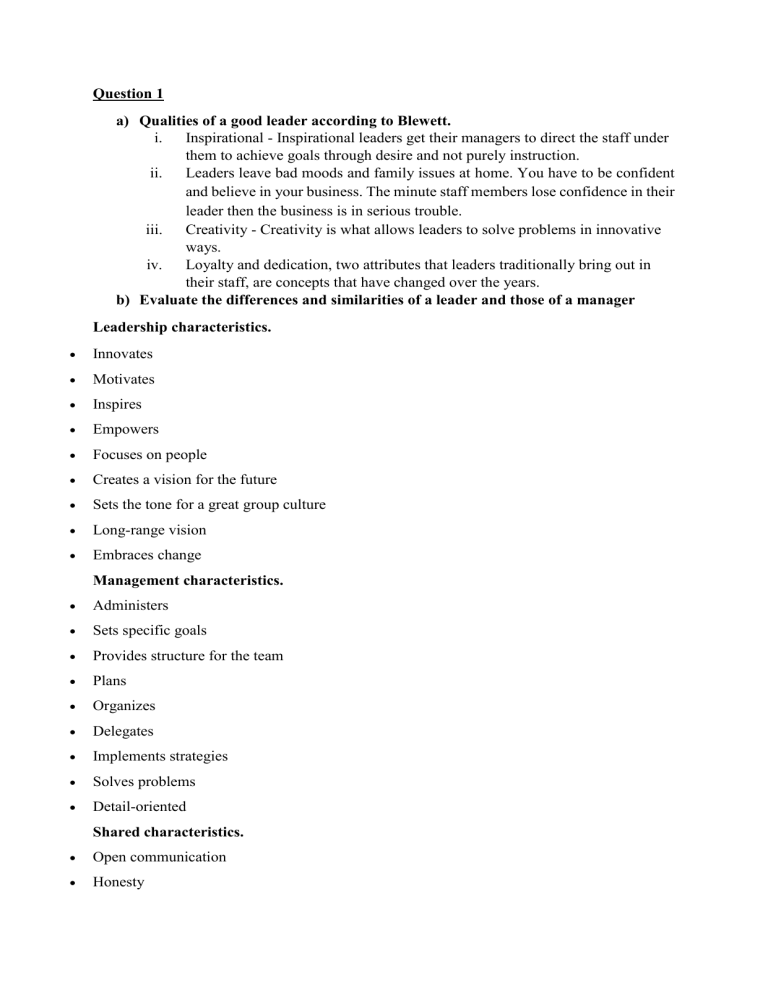
Question 1 a) Qualities of a good leader according to Blewett. i. Inspirational - Inspirational leaders get their managers to direct the staff under them to achieve goals through desire and not purely instruction. ii. Leaders leave bad moods and family issues at home. You have to be confident and believe in your business. The minute staff members lose confidence in their leader then the business is in serious trouble. iii. Creativity - Creativity is what allows leaders to solve problems in innovative ways. iv. Loyalty and dedication, two attributes that leaders traditionally bring out in their staff, are concepts that have changed over the years. b) Evaluate the differences and similarities of a leader and those of a manager Leadership characteristics. Innovates Motivates Inspires Empowers Focuses on people Creates a vision for the future Sets the tone for a great group culture Long-range vision Embraces change Management characteristics. Administers Sets specific goals Provides structure for the team Plans Organizes Delegates Implements strategies Solves problems Detail-oriented Shared characteristics. Open communication Honesty Integrity Decisiveness Respect Empathy Creativity Confidence Optimism Commitment c) Analyse some of the barriers to leadership creativity What stifles leadership creativity is getting into a standard organizational way of thinking. Exercising the mind like a muscle is critical to keeping the creative part of the brain alive. Loyalty and dedication, two attributes that leaders traditionally bring out in their staff, are concepts that have changed over the years. Old habits, beliefs, and assumptions cloud openness to new ideas and overpower creative and innovative initiatives. The status quo remains in place and nothing changes. Employees who have ideas are reluctant to share because they worry that no one will like the idea. They are afraid of ridicule or the implications of possible failure. d) How does a good leader get employees to be dedicated to their jobs? But you will get dedicated and loyal people when you create a working environment where people feel they can think freely and express themselves Leadership is allowing your employees the space to move and not being over critical of their decisions People's dedication to jobs comes when they are allowed to bring their own flair to their positions. This breeds passion and enjoyment, which results in staff members being dedicated. Question 5 Explain the following a) Delegation Delegation is commonly defined as the shifting of authority and responsibility for particular functions, tasks or decisions from one person (usually a leader or manager) to another. While that is probably the most common understanding of the term, there are those who define the term more narrowly. But before we talk about what others say delegation is, let’s be clear on what it isn’t. Delegation is not dumping or abdicating personal responsibility. Rather, it is about spreading it out in way that best advances the organization’s short- and/or long-term cause. “Delegating work works, provided the one delegating works too.” Robert Half Delegation does not involve telling people what to do. Rather, it involves explaining the outcomes and results they are expected to achieve. They are then expected to work out the 'how' and the steps involved. Delegation is not the distribution of tasks, as if simply passing along things from a leader’s personal to-do list (also called leadership abdication). Most delegated tasks take some time, planning and effort to complete properly. Delegation does not look the same in every situation. Many factors go into determining what to delegate, when to do so, to whom and how the leader-subordinate relationship will look over the lifetime of the project. Delegation is not about punting away your weaknesses. As a leader, you aren’t going to be able to do every little bit of every project, even when it speaks to your strengths and passion. Of course, there are going to be things that you don’t do as well or enjoy as much as others (just make sure that it’s not a fixed mindset speaking!) But, for the most part, delegation should be viewed as a way of building upon existing strengths and getting things done more quickly and completely. Delegation does not mean you can’t do it all yourself. Instead, it means you’re a strong enough leader that you can identify projects that would be good for others on your team. b) Job enlargement The definition of job enlargement is adding additional activities within the same level to an existing role. This means that a person will do more, different activities in their current job. For example, an employee who will now also manage her own planning where this was formerly done by her manager. Job enlargement is a key technique in job redesign, along with job enrichment, job rotation, and job simplification. Job enlargement is often confused with job enrichment. However, there is a distinct difference. Job enlargement aims at broadening one’s job in order to make the job more motivating. Job enrichment is the process of adding motivators to existing jobs. This means that job enlargement is a way to do job enrichment but not all job enrichment activities are also considered job enlargement. We will explain this in more depth later. One of the key characteristics of enlargement is that it broadens the scope of the job horizontally. It is for that reason also referred to as horizontal expansion and is the opposite of specialization. In specialization, a division of labor is created where individuals execute specialized tasks. The thinking here is that the individual will be highly effective in executing these tasks. Job enlargement does the opposite. This brings us to the benefits and drawbacks of job enlargement. Job enlargement advantages Job enlargement was popularized in the ’60s and ’70s. During that time there was an increase in attention on factors that made a job motivational as people realized that the traditional mass production assembly lines were boring and deeply dissatisfying to work at. Enlarging highly specialized jobs leads to a number of advantages. 1. Creating a wider range of activities. In essence, job enlargement is about adding responsibilities to existing roles. This makes the job more varied, creating a wider range of activities. 2. Reduces monotony. As a result of the wider range of activities, monotony decreases. People don’t do the same, highly specialized task 30 times an hour for 9 hours straight. Instead, they are more involved from end-to-end, taking a single product through multiple production phases, or even managing an automated assembly belt. 3. Teaches a variety of skills and helping career growth. Additional job responsibilities require training and help in building additional experience. This teaches employees additional skills and is helpful in terms of career growth. 4. Earn a higher wage. Adding responsibilities to a role often results in better compensation. Higher wages are a specific benefit for the employee. 5. Gives more autonomy, accountability, and responsibility. The additional responsibilities lead to a number of motivational factors. Because the person is now responsible for multiple related activities, the person has more freedom over how they do their work leading to more autonomy. In addition, they are more accountable for mistakes and product quality as they experience more ownership and responsibility as they have more interaction with a single product or service (compared to when they were specialized). c) Job enrichment Job enrichment is a motivational technique which emphasizes the need for challenging and interesting work. It suggests that jobs be redesigned so that intrinsic satisfaction is derived from doing the job. In its best applications, it leads to a vertically enhanced job by adding functions from other organizational levels, making it contain more variety and challenge and offer autonomy and pride to the employee.” Job enrichment is thus, an important practice in meeting “whole man” needs. It represents a new and popular nonmonetary motivational technique. It applies to improvement of job in such a way that it has more motivators than before and at the same time maintaining the degree of maintenance factors. Direct Feed Back: There should be a direct feed back of the employees performance. Employees should be able to get immediate knowledge of the results they are achieving. The job evaluation can be inbuilt in the job or provided by a supervisor. 2. Client Relationships: - When an employee serves a client or customer directly, he has an enriched job. The client can be outside the organization or inside. 3. New Learning: - An enriched job allows the employee to learn more. He should feel that he is growing mentally. An employee, who is doing some intellectual work, is having an enriched job. 4. Scheduling Own Work: - Freedom to schedule one’s own work contributes to enrichment. Deciding when to tackle which assignment is an example of self scheduling. Employees who perform Creative work have more opportunity to schedule their assignments as compared to employees performing routine jobs. 5. Unique Experience: An enriched job has some unique qualities or features as compared to the other jobs. 6. Control Over Resources: One approach to job enrichment is that each employee should have control over his own resources and expenses. 7. Direct Communication Authority: An employee holding the enriched job will be allowed to communicate directly with people who use his output. 8. Personal Accountability: An enriched job holds the incumbent responsible for the results. He receives praise for good work and blame for poor work. Questions 4 Analyse the importance of organizational goals in the management of organizations Importance of Organizational Goals[3] Organizational goals are essential to regulate and control the functioning of individuals and groups inter se and also individuals and group in relation to organization. Importance of these goals has been described under the following heads: 1. Focus Attention of Individuals and Groups to Specific Activities and Efforts of Organisations: When organisation’s goals are known to individuals and group, it will help them in channelizing their activities towards attaining organisation’s goals. In other words the goals prescribe the course of action to individuals and groups which will be helpful and complementary to the achievement of organisation’s goals. 2. Provide a Source of Legitimacy to Action by Members: Once this course of action has been decided for the individuals and the groups within the framework of organisational goal, it will promote legitimacy and justification to individual’s or group’s actions and decisions. 3. Serve as a Standard of Performance: Goals provide a measure of individual’s or group’s performance. They may help the organisation members to evaluate the level of their performance in the perspective of organisation’s goals. 4. Affect the Structure of Organisation: Goals and structure are intimately related to each other. The relationship among people in the form of authority and responsibility or the positions to be created at different levels has to be decided on the basis of organisational goals. In other words, what the organisation proposes to do will be determined by the organisational setup it will structure. Similarly, it will be the structure also which will influence the goals. 5. Provide Clues about the Nature and Character of Organisation: The nature and character of an organisation may be known by its goals. For instance, the goal of maintaining the quality of product without much regard to return on investment may help the outsider to hold the organisation and its members in very high esteem. Goals help define a company's purpose, assist its business growth and achieve its financial objectives. Setting specific organizational goals can also help a company measure their organization's progress and determine the tasks that must be improved to meet those business goals. Goals need to be specific, measurable, achievable and timely. By setting clear, realistic goals, organizations have a clearer path to achieve success and realize its vision. Goal setting, and attaining them, can also help an organization achieve increased efficiency, productivity and profitability. Organizations should clearly communicate organizational goals to engage employees in their work and achieve the organization's desired ends. Having a clear idea of organizational goals helps employees determine their course of action to help the business achieve those goals. Employees should also be equipped with the proper tools and resources needed as they do their work to help meet the overall organizational goals. Setting goals can also help companies evaluate employee performance -- for example, creating individual employee goals that support overall organizational goals and measuring individual performance against those individual goals. While an organization can communicate its organizational goals through formal channels, the most effective and direct way to do so is through employees' direct supervisors. This enables managers to work with their staff to develop SMART (specific, measurable, achievable, realistic and time-bound) goals that align with the organization's goals. Setting organizational goals also helps build workplace harmony because it makes employees work toward attaining similar goals. Question 2 10 Reasons Why Corporate Responsibility Is Important Corporate responsibility, also known as corporate social responsibility (CSR), has become a buzzword in recent years. What is it exactly? When a business contributes to goals associated with social activism, it is embracing corporate responsibility. This includes paying attention to how business practices impact marginalized groups, the environment, and society as a whole. Incentivizing volunteer work for employees, setting up charitable funds, and revising ethical guidelines to go above and beyond also play a part in CSR. Why is corporate responsibility important? Here are 10 reasons why: #1. It encourages customer loyalty People are giving to charitable organizations in high numbers. Millennials are especially active. To attract customers and keep their loyalty, corporations need to pay attention to what customers care about. If a customer feels like they are living out their values by supporting a certain business, they are more likely to stick with the brand. They’ll feel a sense of pride when buying from the business and are more likely to recommend it. Loyal customers are the best marketing a company can get. #2. It gives businesses a competitive edge Customers care about a business’s part in social issues and they will be loyal to corporations they believe align with their values. That means corporations that cater to these customers have a competitive edge over companies that don’t. They might offer the same products and services, but the fact that they are making corporate responsibility a priority makes them more appealing. Drawing that distinction is essential for marketing purposes. #3. Corporate responsibility makes employees happier and more fulfilled Research shows that employees of businesses that prioritize CSR are happier and more fulfilled. 80% of employees report feeling more purpose when they believe their work makes a difference in the world. That sense of purpose is essential to employee loyalty and dedication. When personally fulfilled, people are less vulnerable to fatigue and stress. They’re also more likely to stay with the company. #4. It makes a business more sustainable When a corporation decides to make corporate responsibility a focus, it needs to be more innovative and creative. It can’t be “business as usual.” Nurturing innovation and creativity forces a company to stay relevant and adjust according to what customers want. These days and for the foreseeable future, customers want social responsibility. The ability to adapt is important for longevity and sustainability. #5. Customers are willing to pay more Corporate responsibility is great for business in a few ways. One of them is that companies can charge more for their products and services. A Nielsen Global Survey of Corporate Social Responsibility revealed that more than half of the surveyed customers are willing to pay more if the company is committed to corporate responsibility. #6. It attracts more investors Investors care about a business’s sustainability, customer loyalty, and competitiveness. There are also many eager to support companies that work to make the world better. Corporations that commit to social change and are willing to adapt are very attractive to investors. Incorporating CSR is an effective way to attract socially-minded investors as well as those thinking about long-term financial success. #7. Corporate responsibility attracts more employees The generations that really care about social justice and social change will make up the majority of the workforce. 66% of people surveyed in the Nielsen Global Survey of Corporate Social Responsibility prefer to work for companies that prioritize corporate responsibility. By embracing that, a corporation can attract the best employees and keep them, making the business stronger. #8. Corporate responsibility can reduce costs Making money has been the primary goal of “business as usual,” but corporate responsibility doesn’t mean a company sacrifices profits. In fact, it can reduce costs. Since General Mills installed an energy monitoring system, they’ve saved millions of dollars each year. While equipment can cost a company initially, it saves money in the long-term. When reduced costs and higher-priced products are combined, companies can make a very good profit by being socially responsible. #9. Corporate responsibility opens up new opportunities/markets There are a lot of markets that haven’t been tapped into because traditional business thinking doesn’t see them as “profitable.” With social activism on the brain, corporations can open new doors into neglected areas and causes. In considering social impact as well as profit, corporations can find a balance and set themselves apart from the crowd. Consumers will appreciate that a corporation is thinking about where it can help and not only about profits. #10. Corporate responsibility makes the world a better place Businesses, especially big corporations, can change society in significant ways. They have a lot of influence, so they can not only raise awareness of issues, they can play an essential role in progress. Addressing climate change is a prime example of where corporations can take charge. By taking responsibility for their impact, corporations can help the world become a healthier, happier place. Question



